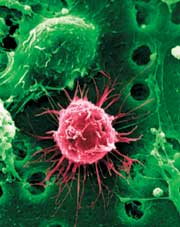
Experts increasingly believe that stem cells have
considerable potential to treat many of our most devastating disorders,
including diabetes, heart disease, and variety of neurological disorders
such as spinal cord injury (SCI). This article specifically covers the
stem-cell program the Dutch company Cells4health (C4H) developed. Widely
discussed in the Internet SCI community, this program attempts to restore
some function after SCI through the transplantation of adult stem cells
isolated from patientís bone marrow.
As discussed elsewhere,
adult stem cells are found in
numerous tissues, including bone marrow. Although they usually
differentiate into specialized cells associated with the originating
tissue, when certain cues are provided, they can differentiate into cells
associated with other tissue. For example, under appropriate
circumstances, bone-marrow stem cells can differentiate into nerve cells.

C4H Methods
The C4H program collects bone-marrow
cells from the patient through a puncture in the iliac crest bone (the hip
bone) in which a large quantity of bone marrow is concentrated. Because
these cells are from the patient, they will not be rejected as can be the
case when the transplanted material is obtained from a genetically
different donor. According to C4H CEO Dr. Cornelis Kleinbloesem, the
extraction is a relatively simple, painless procedure (using local
anesthesia when needed) with no side effects. The isolated stem and other
bone-marrow cells are processed through a proprietary process, which
Kleinbloesem claims is a key factor in the programís success.
The cells are then injected into the patientís spinal
cord at the lesion area through 20-40 microinjections. Cumulatively, about
two-milliliters of the stem-cell preparation, corresponding to about 10-20
million cells, are injected above, below, and around the injury site using
an insulin needle. Carried out under total anesthesia, the procedure
requires a laminectomy at the lesion level and the opening of the cordís
dura membrane. In the future, Kleinbloesem speculates on the possibility
of using computer-assisted, neuro-navigation injections.
The company is also considering the less invasive
intrathecal transplantation of cells directly into the spinal-cord fluid.
This is not an insignificant change because the site of transplantation
(i.e., the cord itself or spinal-cord fluid) may profoundly affect
outcomes one way or another.
Although patients with any injury or at
any age are potential candidates for the procedure, those whose cord has
been transected or atrophied are not currently eligible. Kleinbloesem
believes that this exclusion may be dropped in the future by using a
stem-cell-containing gel to bridge the spinal-cord gap, similar to what
other programs have done. The company also may incorporate neural growth
factors in such a gel to enhance regeneration.
Results
Of the nine patients with chronic SCI
treated in the first half of 2005, eight reportedly have had positive
results. In three of the first four treated in February, 2005, MRI
imaging indicated that the lesion size was reduced by half three months
after surgery, data suggesting the creation of new neural cells and
supporting structure.
As gleaned from several sources, cell
transplantation appeared to have restored significant function and
sensation in three of these four initial patients. Two to three months
after transplantation,
the first patient, who sustained
a T6-complete injury four years earlier from a car accident, reportedly
recovered function to the T12- L1 level and was able to move legs, walk a
few steps using a walker, and stand.
The second patient, who had sustained a
complete cervical-level C5-6 injury seven months earlier, a
month and half after surgery was said to be able to
move legs and fingers and feel toes, and
regained rectal and bladder sensation.
Several months after transplantation,
the third patient, who sustained a complete C5-6 injury nine months
earlier from a surgical complication, reportedly regained his ability to
stand, ambulate using a walker with leg braces, and write. Also, his
sensation returned to near normal, and he regained rectal control.
The fourth patient accrued no benefit,
perhaps because his spinal cord turned out to be transected.
Five additional patients had the procedure in May
2005 and, according to C4H officials, at the time of this report, they
regained some promising sensation, which Kleinbloesem predicts will be the
precursor of restored function. Although too early to report on results,
additional patients were treated in the latter half of 2005.
For patients considering the procedure,
it is important to underscore that many of the results were, in fact,
reported by C4H, a for-profit organization and not scientifically verified
by independent sources.
Additional Information
C4H is a Dutch holding company with international
affiliates and professional associations and whose core competence resides
in the extraction, processing, storage of adult stem cells for therapeutic
applications. Concerning SCI, the company coordinates and subcontracts the
necessary expert functions regarding cell implantation. To date, C4H has
used Turkish medical facilities and neurosurgeons.
The patients stay in the hospital
approximately 10 days, a period that includes the extraction of cells from
the patientís hip, cell processing (done in a United Kingdom facility),
cell implantation, and a few days for post-surgical recovery. C4H
coordinates all logistic aspects in Turkey. As of January 2006, cost of
the procedure is 16,500 Euros (~$21,000), excluding travel and related
expenses.
Conclusion
The C4H stem-cell program for SCI is one of many
emerging throughout the world. Although the emergence of these programs is
certainly a promising sign, questions remain concerning both safety and
effectiveness. As such, candidates for such procedures should carefully
weigh, relative to their unique situation, potential benefits that may
accrue against the inherent risks associated with any invasive surgery, as
well as, to date, poorly understood, unanticipated stem-cell risks.
Stem-cell transplantation procedures vary substantially in many respects
from program to program, and, as a consequence, so can results. When it
comes to function-restoring stem-cell programs, the devil will be in the
details.
In addition to the C4H website
www.cells4health.nl/health-spinalC/en/, the program has been
extensively discussed on the CareCure website
http://carecure.org.
Adapted from article appearing in March 2006 Paraplegia News (For subscriptions,
call 602-224-0500) or go to www.pn-magazine.com).
TOP